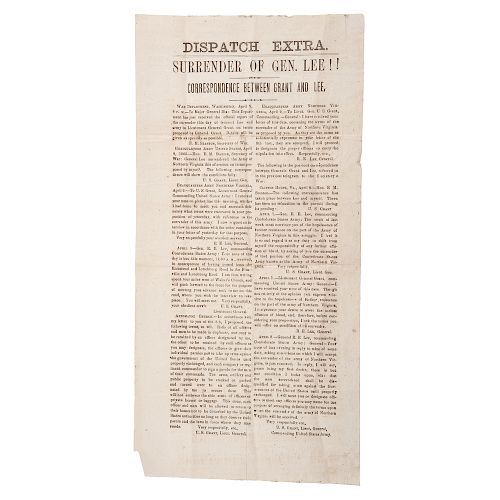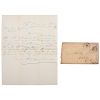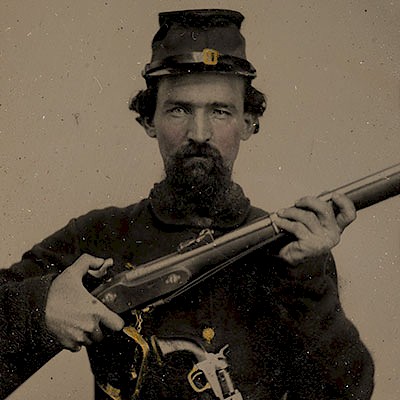Rare Broadside Announcing the "Surrender of Gen. Lee!!" Incl. ALS by Colonel Thomas Boone, 115th Ohio Infantry
About Seller
6270 Este Ave.
Cincinnati , OH 45232
United States
With offices in Cincinnati, Cleveland and Denver, Cowan’s holds over 40 auctions each year, with annual sales exceeding $16M. We reach buyers around the globe, and take pride in our reputation for integrity, customer service and great results. A full-service house, Cowan’s Auctions specializes in Am...Read more
Two ways to bid:
- Leave a max absentee bid and the platform will bid on your behalf up to your maximum bid during the live auction.
- Bid live during the auction and your bids will be submitted real-time to the auctioneer.
Bid Increments
| Price | Bid Increment |
|---|---|
| $0 | $25 |
| $500 | $50 |
| $1,000 | $100 |
| $2,000 | $250 |
| $5,000 | $500 |
| $10,000 | $1,000 |
| $20,000 | $2,500 |
| $50,000 | $5,000 |
| $100,000 | $10,000 |
About Auction
Jun 21, 2019
On June 21, Cowan’s Auctions will be offering a remarkable selection of historic photography, letters, documents, flags, political ephemera, and more representing the Revolutionary War-period through the Civil War, Indian Wars, and beyond, as well as the American West. Cowan's Auctions dawnie@cowans.com
- Lot Description
Printed broadside, 5.75 x 12 in., announcing the " Surrender of Gen. Lee!! " N.d., ca April 1865. Bold text featured at top reads " Dispatch Extra ," with headline " Surrender of Gen. Lee!! " printed underneath. Excerpts of correspondence between General U.S. Grant and CSA General Robert E. Lee are presented below, including Grant's entreaty from April 7, 1865 in which he highlights the " hopelessness of further resistance on the part of the Army of Northern Virginia ," and requests Lee's surrender. Lee responds by asking for terms of surrender, to which Grant famously replies, in part, " ...peace being my first desire, there is but one condition I insist upon, viz: that the men surrendered shall be disqualified for taking arms against the Government of the United States until properly exchanged ."
Boone, Thomas C. ALS as Colonel, 1p, approx. 7.75 x 9.75 in., " Murfreesboro ." June 24, 1865. Colonel Thomas C. Boone of the 115th Ohio Infantry was mustered out two days prior to the date on this letter. In the letter, he writes that he is in " good health & spirits ," and that he will be leaving camp the following day to return home.
Cover addressed to " Mrs. Thos C Boone " of Salem in Columbiana County, Ohio, and cancelled at Murfreesboro, April 1865, with three-cent postage stamp affixed at upper right corner. Though this cover is included with the letter featured in this lot, the date on the cancel suggests the two were not mailed together. The cover could have contained the broadside, however.
Thomas C. Boone enlisted as a private on July 20, 1862 and mustered into the 115th Ohio Infantry Field and Staff two months later as a lieutenant colonel. The 115th Ohio performed much of the dirty work necessary in the western theatre during the Civil War. Raised primarily in Columbiana County and mustering into the federal service at Camp Massillon in August 1862, the regiment was temporarily split early up in its service, with roughly half, under the command Lt. Colonel Thomas Boone, assigned to guard duty at Camp Chase Prison and the other half to duty at Cincinnati. Overseeing both political and military prisoners at a time of profound instability in the state, Boone was at the epicenter of a vicious legal battle, caught between the state's Copperhead civil authorities who had issued a writ of habeas corpus for the outspoken Peace Democrat Clement Vallandigham and his own commanding general, Ambrose Burnside, who had ordered that all habeas corpus orders from state be ignored. As a military man, Boone followed his commander's orders, even after a judge ordered his arrest: only the body guard he had gathered around him prevented the arrest from being carried out.
From the late summer 1863 through the end of the war, Boone and his regiment were assigned to suppress guerrilla activity in Kentucky and Tennessee and to ward off the periodic raids from Confederate forces. In July 1863, he pursued John Morgan during the raid into Ohio, and he saw a series of sharp engagements at Lavergne, TN, on August 31, 1864, and during Hood's campaign near Nashville in December 1864. On December 4 that year, he commanded a detachment of the 115th, supplemented with "Colored" troops from the 14th and 44th USCT, which was assigned to defend a series of stockades and block houses. He fought fiercely until forced to retreat in good order to Nashville. Following his promotion to the rank of colonel on July 20, 1864, Boone was cited for taking command of the 3rd Michigan at Murfreesboro on December 7, 1864, and inflicting heavy losses on Confederate General Abe Buford. He remained in Tennessee until the end of the war, and was mustered out on June 22, 1865 at Murfreesboro.Broadside with brittleness and some wear/minor loss to edges, horizontal and vertical creases, and some very light ink staining along bottom edge (presumably from being folded in half). Letter with strong creases, wear to left edge (with minor loss to upper left corner), and light discoloration. Cover quite worn, with moderate to heavy surface soil, wear to edges (including full separation/loss along left edge), and ink smearing.Condition
- Shipping Info
-
Buyers are required to pay for all packing, shipping and insurance charges. Overseas duty charges are the responsibility of the successful Bidder. Be aware that for larger and/or valuable items, shipping charges can be substantial. - If there is no shipping amount on listed your invoice, you will need to make arrangements to pick up or ship your purchase through an alternative shipping company. Our shipping department can be contacted at 513.871.1670 (ext. 219) or email shipping@cowans.com. - Shipping charges include insurance for your order while in transit. If you have private insurance we will adjust your charge to include only packing and shipping. - Please allow 14 – 21 days after payment to package and ship your purchase as carefully as possible.
-
- Buyer's Premium



 EUR
EUR CAD
CAD AUD
AUD GBP
GBP MXN
MXN HKD
HKD CNY
CNY MYR
MYR SEK
SEK SGD
SGD CHF
CHF THB
THB












